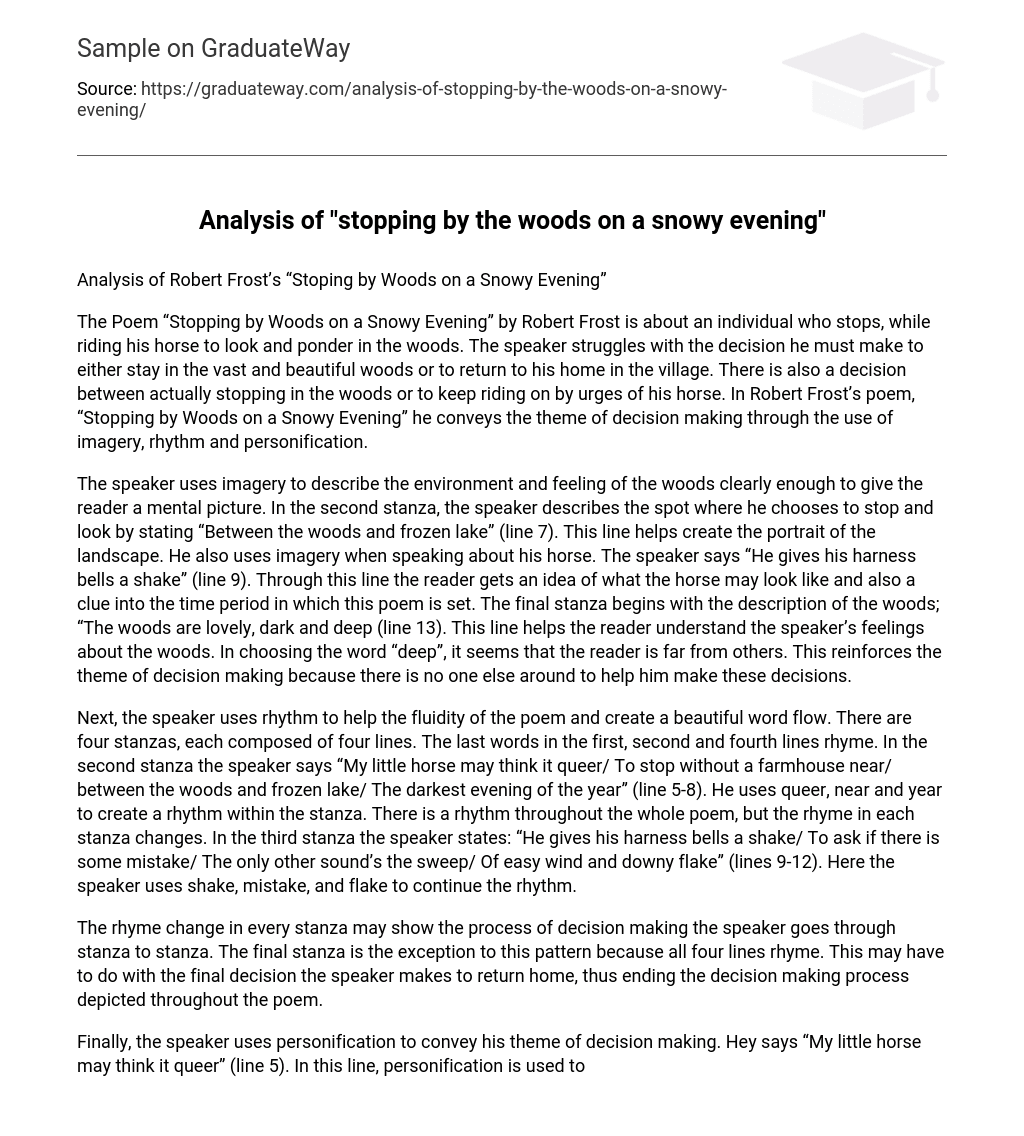Analysis of Robert Frost’s “Stoping by Woods on a Snowy Evening”
The Poem “Stopping by Woods on a Snowy Evening” by Robert Frost is about an individual who stops, while riding his horse to look and ponder in the woods. The speaker struggles with the decision he must make to either stay in the vast and beautiful woods or to return to his home in the village. There is also a decision between actually stopping in the woods or to keep riding on by urges of his horse. In Robert Frost’s poem, “Stopping by Woods on a Snowy Evening” he conveys the theme of decision making through the use of imagery, rhythm and personification.
The speaker uses imagery to describe the environment and feeling of the woods clearly enough to give the reader a mental picture. In the second stanza, the speaker describes the spot where he chooses to stop and look by stating “Between the woods and frozen lake” (line 7). This line helps create the portrait of the landscape. He also uses imagery when speaking about his horse. The speaker says “He gives his harness bells a shake” (line 9). Through this line the reader gets an idea of what the horse may look like and also a clue into the time period in which this poem is set. The final stanza begins with the description of the woods; “The woods are lovely, dark and deep (line 13). This line helps the reader understand the speaker’s feelings about the woods. In choosing the word “deep”, it seems that the reader is far from others. This reinforces the theme of decision making because there is no one else around to help him make these decisions.
Next, the speaker uses rhythm to help the fluidity of the poem and create a beautiful word flow. There are four stanzas, each composed of four lines. The last words in the first, second and fourth lines rhyme. In the second stanza the speaker says “My little horse may think it queer/ To stop without a farmhouse near/ between the woods and frozen lake/ The darkest evening of the year” (line 5-8). He uses queer, near and year to create a rhythm within the stanza. There is a rhythm throughout the whole poem, but the rhyme in each stanza changes. In the third stanza the speaker states: “He gives his harness bells a shake/ To ask if there is some mistake/ The only other sound’s the sweep/ Of easy wind and downy flake” (lines 9-12). Here the speaker uses shake, mistake, and flake to continue the rhythm.
The rhyme change in every stanza may show the process of decision making the speaker goes through stanza to stanza. The final stanza is the exception to this pattern because all four lines rhyme. This may have to do with the final decision the speaker makes to return home, thus ending the decision making process depicted throughout the poem.
Finally, the speaker uses personification to convey his theme of decision making. Hey says “My little horse may think it queer” (line 5). In this line, personification is used to give the horse a thought and opinion. This gives the impression that the speaker may take his horse’s actions into consideration during his process of making decisions. The speaker also uses personification in lines 9 and ten when he says “He gives his harness bells a shake/ To ask if there is some mistake” (lines 9-10). These lines give the horse a voice to ask a question and also and opinion about being alone in the woods. Although rationally the speaker probably knows his horse’s actions are simply instinct, when he is alone it is probably comforting to think his horse is interacting with him.
In the beginning of the poem the speaker seems to be pondering the idea of staying in the woods for a while by stating: “Whose woods are these I think I know/ His house is in the village though/ He will not see stopping here” (lines 1-3). This is the beginning of his decision making process. The speaker follows with descriptions of why he would like to stay in the woods and also his hesitations through personification of his horse. The decision making process comes to an end when he says “But I have promises to keep/ And miles to go before I sleep” (lines 14-15). This line portrays the speaker’s final decision to return home to his commitments. The poem “Stopping by the Woods on a Snowy Evening” by Robert Frost is about an individual making decisions alone.





